Electric ultralight motorgliders seem like a logical first step in current-driven aeronautics, having long wings to carry the added weight of batteries aloft, ease of certification and pilot licensing to keep the authorities at bay, and light weight and simplicity to keep building and operational costs down. A new entry in this category defies convention and brings an array of interesting design details to the fore.
Its maker proclaims, “No multi-engine rating, complex rating, powered-lift rating, glider rating and no medical required. An owner can fly this airplane as a private, glider or ultralight pilot.” These statements become paradoxical as we examine the aircraft.
West Coast Light Metal
Brian Carpenter of Corning, California’s Tangent Aircraft Solutions has not only a wildly unique design, but also an entirely different way of promoting his metal and carbon-fiber aircraft. The EMG-5 plans will be available free on the Internet, much like the Basic Ultralight Gliders (BUGs) of Mike Sandlin.
A potential builder can use the bill of materials to purchase the necessary flat metal stock, follow the instructions and cut, deburr, drill and pop rivet to his heart’s content while producing a copy of the sleek little motorglider. Carpenter will make certain parts available, such as the beautiful carbon-fiber fairings and CNC-machined landing gear, but builders can elect to make their own.
Pilot Placement
The airplane looks like anything but a typical ultralight, its high-aspect-ratio wings blending neatly into the arched pilot enclosure. EMG-5, with its 35.8-foot wingspan, 18.7-foot length and mostly aluminum sheet, is a very sleek aircraft. Its wings can fold without being detached, making storage and transport easy for the 254-pound craft.
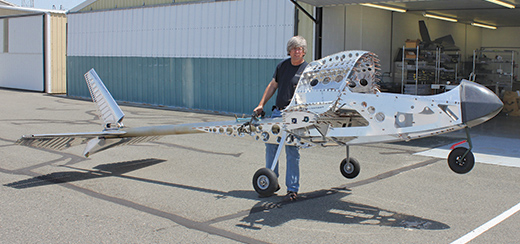
Proof that it just may meet Part 103 weight requirements.
The sleekness can be partly attributed to the prone pilot position, something that allows structure and pilot to coexist with the airplane’s center of gravity. That’s why it’s the EMG-5—because the first four renditions were unable to resolve those tricky equations satisfactorily. The prone position came naturally to Carpenter, a longtime hang-glider pilot used to seeing the world from Superman’s point of view. Since most pilots will come close to equaling the aircraft’s weight, distributing the pilot along the longitudinal axis helps overcome the difficulty of placing the biggest weight in the craft in one carefully chosen spot. It also reduces the problem of dealing with different sizes and weights of occupants, as the mass distribution for a prone pilot will be approximately equal in proportion to total body weight.
Because a pilot will have difficulty exiting the cockpit in a hurry, the entire airplane will be parachuted to safety using a ballistic recovery system. The roll cage, which surrounds and protects the pilot, also acts as an upper wingspar, distributing the carry-through stresses across a broad flange and two bulkheads. Looking a bit Swiss-cheesy, the spar/carry-through/roll cage allows the use of thin stock while giving the greatest strength to this crucial structure.
Wrapping the complex-looking internal structure, a large carbon-fiber fairing covers fuselage top and bottom and blends neatly with the wing fairings. Light carbon wing, stabilizer and rudder tips complete the sleek look, while adding very few ounces.
Trimming ounces and even grams here and there allows inclusion of CNC-machined, retractable landing-gear legs and those exotic pivoting motors.
All of this is assembled around an aluminum-tube tailboom, which carries the pilot’s cushion, a mounting for rudder pedals about halfway along its length and the flanged tail feathers that help provide stiffness with thin materials.
The horizontal stabilizer is fairly conventional in construction, looking like a typical “Spam-can” assembly. The rudder and elevators, however, will have a shell structure without internal ribbing. Stiffness will come from chord-wise “dimpled ridges” in the 0.016-inch, 2024 T3 aluminum. A thin vinyl decal over the exterior of each surface will provide additional stiffness, along with aerodynamic smoothness and a substitute for paint. Carpenter claims this technique makes for quick building and a nice finish.
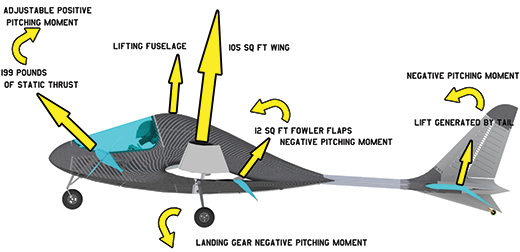
A diagram of the vectors on the EMG-5 shows that the aircraft essentially becomes a lifting body with vectored thrust and a lifting tail.
A Homebuilt with Syntax Interpretation
Despite its complex appearance, the all-metal structure can be made with ordinary hand and power tools, along with a set of Clecoes and Cleco pliers. Taking great care with weight, Carpenter documents scale readings for individual parts and takes steps to pare that weight where necessary. The small wing area, retractable gear, Fowler flaps and twin pivoting motors take the design into a remarkable interpretation of the rules.
Because the EMG-5’s wing has only 105 square feet, it will stall at around 40 mph, too fast for the FAA’s Part 103 requirement of 27.6 mph. Even the Wortmann 61-163 airfoil, well-proven on German sailplanes, needs 6 feet of Fowler flaps on each wing to reach the legal stall speed. This puts a huge pitching moment on a very light airplane. Carpenter couples this pitching moment with a lifting tail and vectored thrust from two Plettenberg 37 motors to end up with high lift, a neutralized pitching moment and FAA-compliant stall speeds.
This may seem like a tricky bit of maneuvering for the average pilot without some computer-assisted flight management. Carpenter parses the FAA’s words carefully when he explains: “In summary, we have two engines producing 200 pounds of vertical thrust, Fowler flaps, 105 square feet of wing area, a lifting body fuselage and a lifting tail configuration. We are currently working under the principle that FAR Part 103 allows both helicopters and Autogyros to operate as legal ultralight aircraft. Since our aircraft is a hybrid version of a powered-lift aircraft, we are allowed to use power to achieve the 24-knot (27.6-mph) power-off stall speed. Our initial inquiries with the FAA have concurred with our conclusions.”
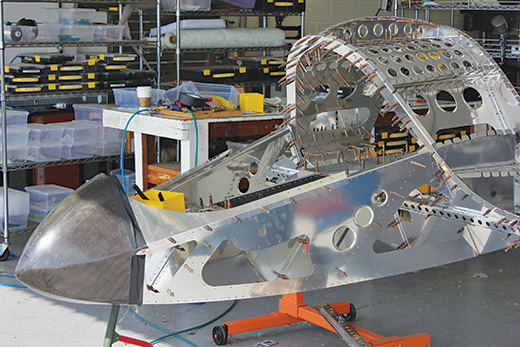
On the Cleco-studded nose of the aircraft, lightening holes show careful design and excellent workmanship.
The Powers That Will Be
Plettenberg motors are high-quality, German-made products, and they have grown in recent years to the model 37, a 4.3-pound (1.9-kilogram) unit that can produce 20.1 horsepower (15 kilowatts), though Carpenter states a conservative 16 hp, and swing a 30-inch propeller. Only 41/16 inches (103 millimeters) in diameter and 321/64 inches (84.5 mm) in length, the motors are capable of pulling extremely large-scale models through the air in “3D” aerobatics, hovering from the prop and even doing vertical maneuvers. Two of these on the nose of the EMG-5 should provide surprising performance. Carpenter claims 99 pounds of thrust from each unit, easily believable from demonstrated performance for smaller Plettenbergs.
Because they are outrunners, the rotating part is on the outside of the motor, with the stationary coil assemblies inside on the motor mount. The rotor, with neodymium magnets inside its cylindrical case, has a propeller-mounting flange encircling the motor mount, through which power leads are routed.
Each propeller and a streamlined spinner rotate around a pair of machined mounts that attach each motor assembly to the fuselage-mounted pivot. Motors will be rotated about the pivot, and both are connected to always be at the same angle of attack, somewhat like a poor man’s Osprey.
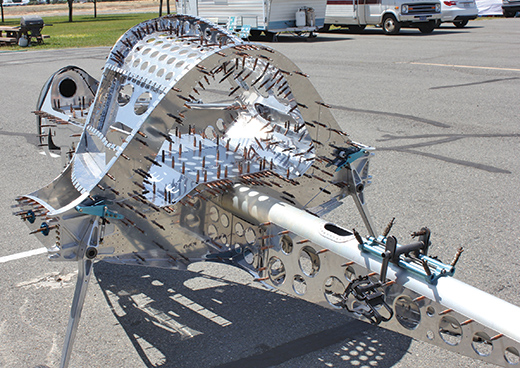
The rudder pedal mounts behind the wing and the retractable gear indicate this is not a “normal” ultralight.
Some Thoughtful Advantages
Carpenter, a longtime ultralight and two-stroke-engine advocate, realizes that things must change. He claims that two-strokes have been good for his enterprise, making his Rainbow Aviation Services maintenance and rebuilding business thrive. He even runs highly successful classes on the care and feeding of these powerplants. This gives credibility to his argument that well-maintained two-strokes are reliable and efficient powerplants. This does not prevent untrained or less careful individuals from having power-failure-related accidents, though.
Neither can he escape the noise issue, which dooms ultralight flying in many communities. On the company web site, Carpenter writes, “In the future we will see airports located in these high-population-density areas be revitalized if we can eliminate the noise issue. Everyone can see the advantages of reducing ground transportation congestion. The electric-powered aircraft will probably be the saving grace for many of these airports.” Noise levels for the twin-motor EMG-5 would be below that of neighborhood cross-fence conversations.
Reliability will be high, based on the small but growing database of operations for electric aircraft. As one of his customers asked, “When was the last time the blower motor in your furnace went out?”
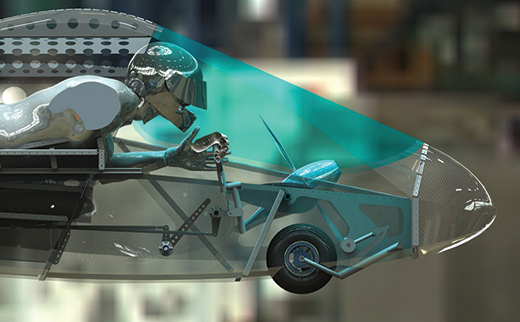
A ghost diagram shows the controls to the motors, landing gear, flaps, elevator and ailerons.
Plans for Future Plans
Drawings will be placed in chapters on the web site, allowing builders to keep track of progress while studying ahead on their next pieces. Carpenter estimates a finished cost of less than $20,000, with the homebuilder’s traditional benefit of having a bought-and-paid-for airplane on the ramp when it’s time to start flight testing.
Tangent will release new plans for components as parts are completed and tested. Carpenter suggests signing up for eDrawings, a free program that allows users to download computer-aided drawings (CAD) for viewing on PCs, Macs and even iPads. A significant number of drawings may be released before the prototype is completed, and having these drawings in soft-copy form should help a potential builder keep up with changes before printing a final version for construction.
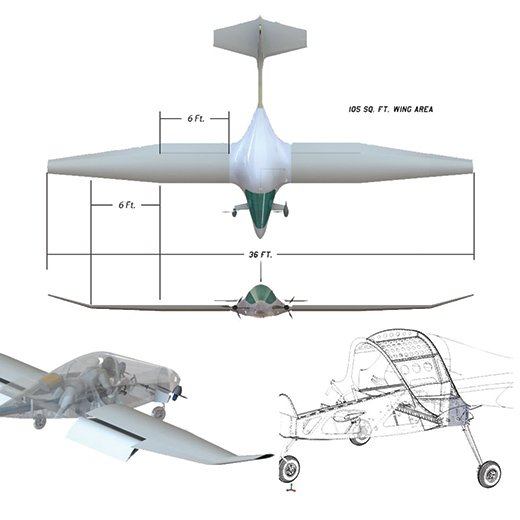
Dimensional drawings and cutaway drawings give perspective on cramming the design features into a compact space.
More to Come
Besides using model-airplane motors, controllers and batteries to power the airplane, Carpenter sees the use of model components to provide gyro-stabilized pitch and yaw control, something we’ve seen demonstrated on the Volocopter from Germany, which uses 16 model motors on its prototype and produces directional control through nuanced differential “throttling” of its powerplants.
Model motors with the appropriate controller algorithms can act as in-flight wind turbines, gathering regenerative power from the air as they soar. Theoretically, this could lead to near-perpetual motion, as demonstrated by Taras Kiceniuk with his model sailplane. Coupled with in-flight adjustable propellers, the airplane could be extremely efficient in producing thrust and extracting energy from the air.
In-flight foldable propellers could allow higher efficiency for pure soaring, with the airplane using solar-driven currents of air to stay aloft. Solar-cell wing coverings could provide direct recharging of onboard batteries. Finally, reverse and vectored thrust could enhance takeoffs, landings and taxiing. Burt Rutan has predicted airshow routines where model-like 3D maneuvering could include hovering nose-down, already demonstrated by radio-control model fliers.
Usually, enthusiasts have their ownership aspirations quenched by sticker shock, that dreadful encounter with financial reality that the aircraft of their dreams has a price higher than a Space Shuttle’s ceiling. In this case, the sticker shock may be much less of a dream killer. With the capabilities of this machine and its low price, many will find it an inspirational quest.
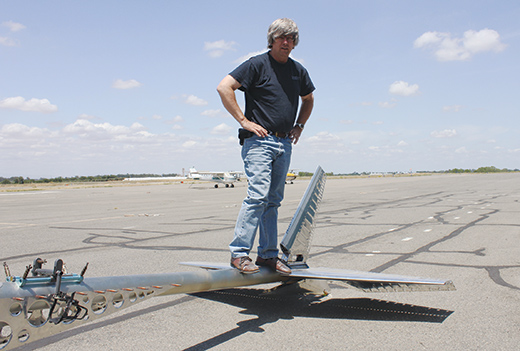
Brian Carpenter demonstrates that the EMG-5 may meet aerobatic structural standards.
Blending model-aircraft power and sophisticated construction and aerodynamics makes the EMG-5 a new ultralight worth watching and waiting for. Brian Carpenter’s forums at Oshkosh had an enthusiastic following and his web site records more than 95,000 hits per month. For an airplane that’s been in the public eye for less than a year, that is a tremendous incentive for Carpenter to keep working—and for the rest of us to keep hoping.
For more on the EMG-5, visit http://electricmotorglider.com/index.html.

![]()
Dean Sigler has been a technical writer for 30 years, with a liberal arts background and a Master’s degree in education. He writes the CAFE Foundation blog and has spoken at the last two Electric Aircraft Symposia and at two Experimental Soaring Association workshops. Part of the Perlan Project, he is a private pilot, and hopes to get a sailplane rating soon.


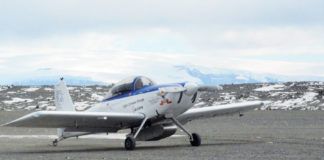
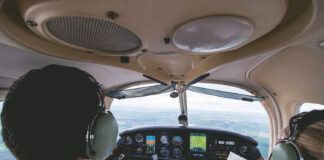
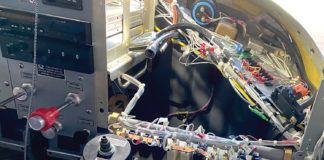
The manufacturer has scrapped the EMG-5 and will devote att of their efforts to the EMG-6. Sad….
I visited several times when the operations were in Corning, California, and was always impressed with Brian Carpenter’s inventiveness and willingness to share his knowledge. I was sorry to see the EMG-5 scrapped, but think the Superman-style flying position would have kept buyer numbers low.